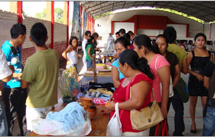Thursday, April 25, 2024
News and Views from the Global South
LATIN AMERICA: Community Currencies Offer Refuge from Economic Forces
Emilio Godoy
- Túmin, which means “money” in the Totonaca indigenous language, is a community currency now circulating among 80 vendors selling their products at an alternative market in the town of Espinal, in the eastern Mexican state of Veracruz.

Market in Espinal where the túmin community currency is used. Credit: Courtesy of Intercultural University of Veracruz
The túmin was launched in November by Juan Castro, a professor at the public Intercultural University of Veracruz, and members of a development research centre and a human rights network in Espinal, 400 km southeast of the Mexican capital.
“We created it to strengthen the local economy, so that people will buy locally and not go outside of their community to spend their money,” Castro told IPS. “It’s gaining acceptance; more and more people are interested in participating.”
The túmin is the latest experiment in Mexico in parallel currency systems, which began to be used at least two decades ago in this Latin American country, although none of them has really taken off.
“We haven’t been able to grow as we would like to,” said Luís Lópezllera, director of Promotion of Popular Development, a local NGO. “We have run up against mistrust and irresponsibility. It’s really hard to get people to believe that credit lies in people, not in the authorities,” he told IPS.
Lópezllera was one of the driving forces behind the Red Tláloc, a network dedicated to the solidarity economy that emerged in 1996, in the wake of the financial crisis that two years earlier had devastated the savings of millions of Mexicans and spread to other countries in a contagious phenomenon dubbed the “tequila effect”.
The network created a directory to enable those offering or looking for goods and services to contact each other and do business using the Tláloc currency, which takes its name from the Aztec god of rain and is equivalent to one hour of community work.
The parties involved in the transaction agree on what proportions will be paid for in Tlálocs or Mexican pesos. The hour of community work is valued at four dollars — the official minimum daily wage in Mexico.
There are currently about 4,000 alternative currencies in the world, which some experts and advocates see as a way for local economies to protect themselves from the swings of major currencies like the euro and the U.S. dollar.
The current downward trend of the euro and the dollar, and the consequent impacts on national currencies, provide an extra incentive for adopting an alternative local unit of exchange that is independent of the ups and downs of outside currencies.
“These currencies have potential in Mexico,” Yves Cabannes, a professor of development planning at University College London, told IPS. “The crisis could foment the use of local currencies, which could also generate access to financial resources, from the local sphere.”
Cabannes, a French national, has studied the evolution of community currencies in depth. One emblematic case is that of the Banco Palmas, a community bank founded in 1998 in Conjunto Palmeiras, a “favela” or shanty town of 30,000 people on the outskirts of the city of Fortaleza, in Brazil’s impoverished northeast region.
Banco Palmas started out distributing credit cards in the favela, and now issues palmas, a social currency that is accepted by some 240 businesses.
The bank manages a credit portfolio worth the equivalent of 1.5 million dollars.
A network of some 50 community banks operates in Brazil, and the central bank, the Banco do Brasil, recognises a similar number of alternative currencies.
In Venezuela, meanwhile, community currencies have the backing of the government of Hugo Chávez and are governed and protected by a 2006 law on community banks.
In Mexico, where the peso has weakened against the dollar, community currencies offer an option for shoring up the buying power of consumers, unlike the peso, according to the experts who spoke to IPS.
But they also stress that the potential of alternative currencies has not been exploited in this country. The community currencies created in several Mexican states have not really taken root, and have failed to gain the official recognition of Mexico’s central bank.
“The problem is how to create alternative currencies that actually contribute to the generation of wealth by communities, without becoming an instrument of power that awakens greed and prompts the authorities or businesses to seize upon them,” says academic Laura Collin.
In her study “Experiencias en torno al dinero alternativo, fortalezas y debilidades” on the strengths and weaknesses of alternative currencies, the professor at the Colegio de Tlaxcala, a public university, also warns of the danger that a currency which is a social symbol could be “exposed to becoming part of the same speculative economic logic of the national currency.”
“We are small oases trying to educate people to accept a healthy currency,” Lópezllera said. “We are trying to spread a ‘positive virus’, where real credit exists, unlike in the international system, where no one knows where the money is.”
In the Tláloc network, which is limited to the greater Mexico City area, participants register, receive training, and offer products and services, grouped by categories. Every year they organise fairs to bring participants together. The next edition will be held in March.
“Alternative currencies avoid fluctuations or depreciations. In time, they gain credibility. Circulation must be steady and must not be interrupted,” said Castro.
The Centre for Intercultural Research for Development and the United for Human Rights Network are also involved in the Túmin community currency initiative.
Cabannes pointed out that for the year 2007, consumption in the Conjunto Palmeiras favela totalled 30 million dollars, in the Banco Palmas project alone. “People aren’t poor because they don’t have money, but because they don’t spend it in their neighbourhoods,” he said.

 Print
Print



